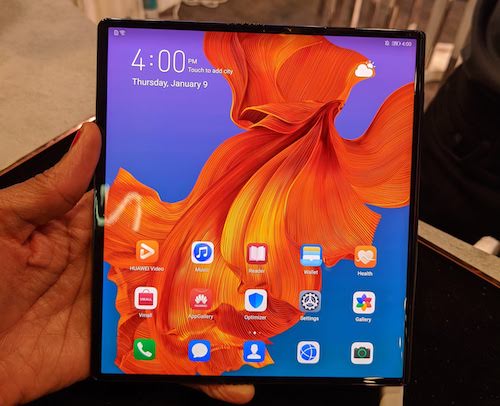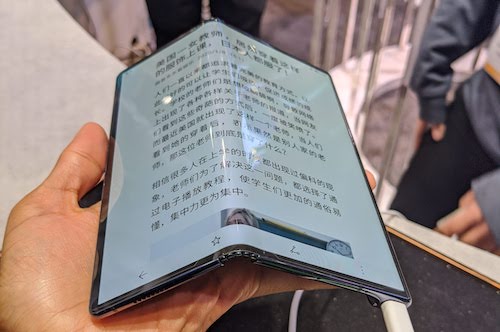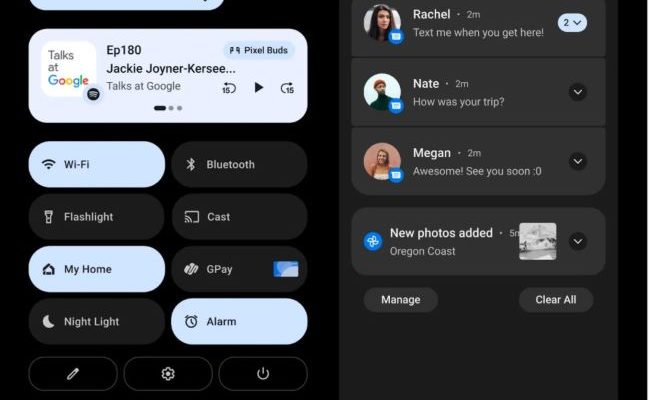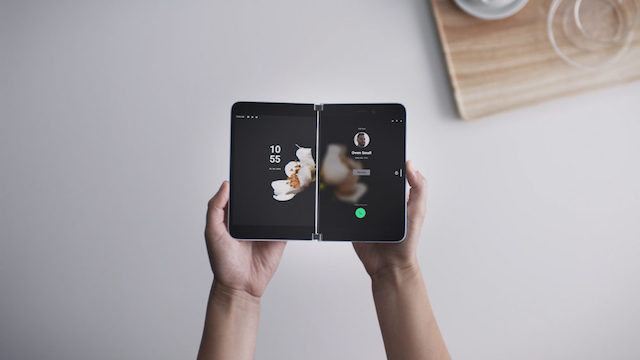Foldable devices were one of the main attractions at CES 2020 last week, proving that the tech industry is not giving up on this unique product form factor. While a number of devices were rehashed from 2019, many others were showcased fresh for the tech conference. Here’s more on the foldables featured at CES 2020.
Lenovo ThinkPad X1
The Lenovo ThinkPad X1 is the brand’s first foldable PC, which is expected to launch in the summer for a whopping $3,000. Lenovo showcased a prototype at CES; however, the manufacturer is aiming to release a fully functioning PC in summer 2020.
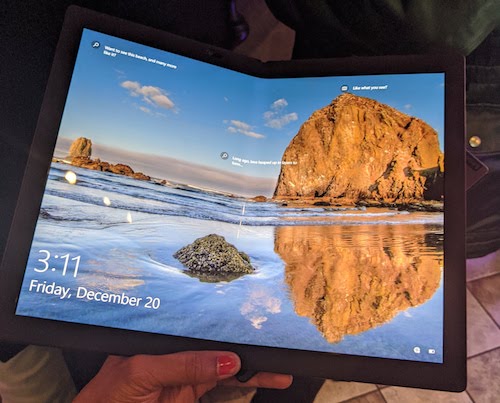
Lenovo ThinkPad X1 tablet mode 
Lenovo ThinkPad X1 laptop mode with keyboard
At first glance, the Lenovo ThinkPad X1 is very fascinating because it has that old-school enterprise laptop vibe. It is on the smaller end with a 13.3-inch display flat; likely for easy portability. Folded it is about the size of a book and its carbon-fiber exterior gives give a high-quality notebook or journal feel.
The Lenovo ThinkPad X1 includes a stylus pen, keyboard, and kickstand as accessories. The folio-style keyboard snaps magnetically onto half of the foldable’s display when it is folded 90-degrees. Users can type just as they would with a standard laptop and can fold the ThinkPad X1 closed with the keyboard inside.
TCL foldable with Dragonhinge
TCL showcased its first foldable prototype featuring its Dragonhinge folding spine technology at Mobile World Congress in 2019 but brought an updated version of the concept to CES 2020. Instead of a continuously folding spine, the handset concept features a stationary spine with two slats that facilitate the device to open and close. The design is similar to the hinge on the Samsung Galaxy Fold.

New TCL Dragonhindge concept 
New TCL Dragonhindge concept
TCL also jazzed the new design up with an angular hardshell design and a reflective green color option. While the brand previously showcased several foldable form factors, this time we saw a singular design concept, indicating that TCL may be focusing on one model at this time. The handset us a booklet style foldable that opens into a tablet and does not feature a front display.
Currently, the brand says it had to immediate plans to bring a device to market.
Dell Ori
Dell showcased its Ori (short for origami) concept at CES, which remains in its early stages of development, but reveals what the brand has in mind terms of developing its foldable display technology.
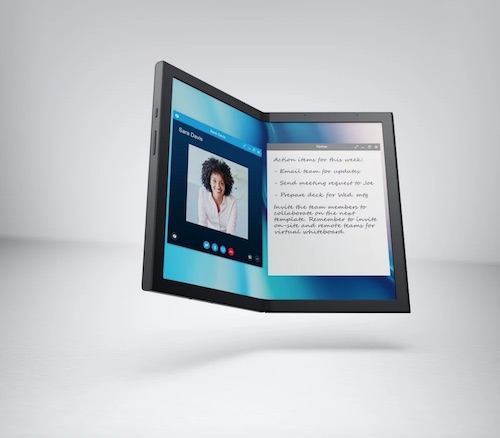
Similar to the Lenovo ThinkPad X1 the device is a foldable PC with a 13.4-inch display and a stylus; however, it does not feature a keyboard attachment. Dell promises the device can withstand up to 15,000 folds. Currently, it is not slated for release in the foreseeable future.
Royole Mirage
Royole fascinated CES 2019 attendees by announcing U.S. availability for its FlexPai foldable, which stands as the world’s first foldable smartphone. The brand has long hinted at being radical with its plans for future foldables and in 2020 it had introduced the Mirage, a smart speaker with a wraparound display that is powered by Amazon Alexa.

The speaker is a collaboration with the audio brand, Cleer, which had outfitted it with three 48mm drivers and a 30W passive bass radiator. It features all the trappings of a smart device. It is powered by the Qualcomm Snapdragon 524 chip and includes 2GB of RAM and 16GB of internal storage. Its display is a 7.8-inch AMOLED touchscreen with 1440 x 1920 resolution.
The Royole Mirage is currently ready for market, with an eyewatering price tag of $899.
Intel Horseshoe Bend
Intel showcased its Horseshoe Bend foldable PC concept, pushing the limits in terms of size, where other brands were conservative. The foldable can vary between a 12-inch laptop when it is bent and a 17.3-inch tablet when it is flat.

Typing options include an onscreen keyboard and an external keyboard. It also features a kickstand, but does not include a stylus. Much like Dell’s concept, this product is not guaranteed for release.
Motorola Razr
Motorola announced its first foldable smartphone in November but the device has since been delayed from its market release for the foreseeable future. Motorola claims high demand for the product has prompted it to rethink its release strategy. But the foldable was on display at Lenovo’s CES station for those who were not able to make it to the launch event.
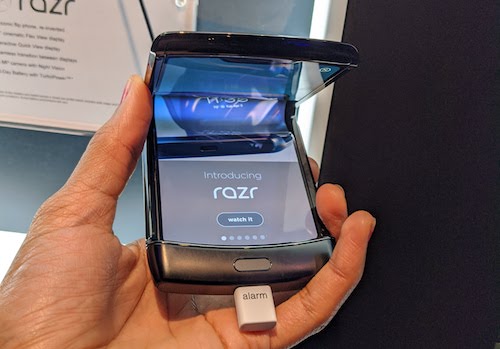
Motorola Razr 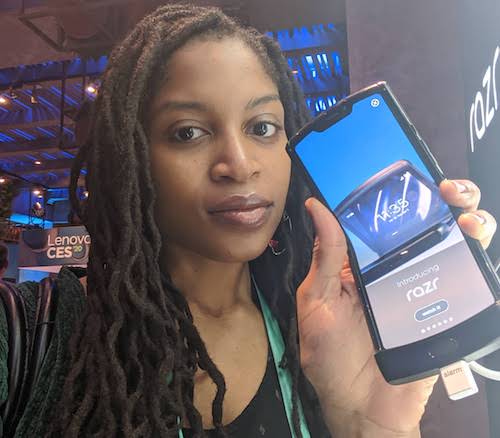
Motorola Razr
Motorola has brought back a tried and true clamshell design from its original Razr flip phones for a bit of nostalgia. The Razr foldable even includes a retro mode Easter Egg that displays a Razr screen and keypad ala 2004 and says “Hello Moto.”
The Motorola Razr will sell for $1,500 (or $62.49 per month for 24-months) as a Verizon Wireless exclusive when released. Motorola also aims to release the device in Canada, Europe, Latin America, Asia, and Australia.
Samsung Galaxy Fold
The new and improved Samsung Galaxy Fold also made an appearance at CES after its harrowing journey to release in 2019. Samsung interestingly allowed fairly hands-on access to the handsets and its booth, as display models were not bound to security cords. However, there were attendants available to assist with handing the models.
Notably, Samsung has reinforced the corners of the handset where it folds and has secured its protective plastic so it won’t be mistaken for a removable cover.
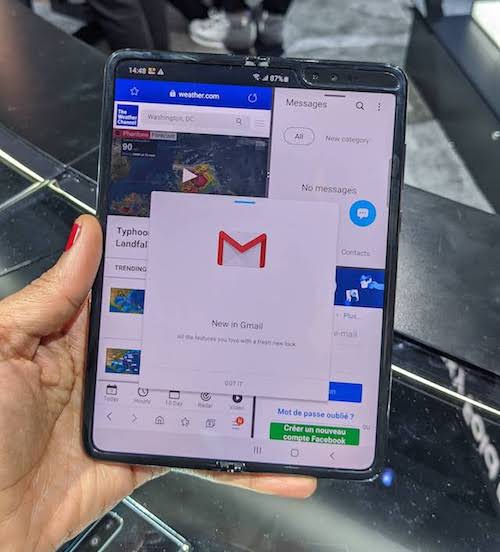
Samsung Galaxy Fold multitask 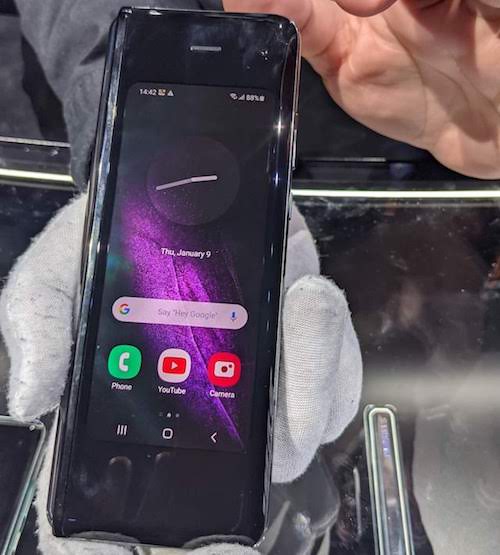
Samsung Galaxy Fold closed
The Galaxy Fold relaunched to largely positive reviews with many who received temporary loans lamenting when they had to return their models. Others who have purchased the device have been pleased with its performance. There have been no major quality mishaps with the Galaxy Fold since its original issues.
Recent reports also indicate that Samsung may have sold between 400,000 or 500,000 Galaxy Fold handsets so far when co-CEO DJ Koh had originally estimated a sales count of about 1 million units.
Huawei Mate X
The Huawei Mate X was caught in the crossfire of the brand’s importing conflict with the U.S. but eventually made it to market in China in November 2019. With Huawei products still barred for sale in the U.S. conferences such as CES is one of the few opportunities for many interested in the device to get hands-on time.
Much like many other foldable smartphones, the Mate X was delayed for several months after its intended release. The brand was able to make reinforcing tweaks in the device after the initial mishap with the Samsung Galaxy Fold. The device remains one of the more unique foldable form factors, as it folds outward, allowing for display real estate on each side, rather than folding inward like a book.
Despite its limited availability, Huawei claims the Mate X is selling well, at a rate of 100,000 handsets per month. The device sells for 16,999 yuan or about $2,400 or €2,200.
Conclusion
While foldables in 2019 continued a smartphone model, 2020 has already shown that manufacturers are ready to experiment with how far they can push the boundaries of what is possible is a flexible display. While many of the foldable products showcased at CES were not ready for market, many of these same brands have a number of devices they plan to release in 2020. Similarly, these devices may see varied sizes, form factors, and prices than we saw in 2019. Ultimately, foldables appear to have made their market on the industry and aren’t going away.


